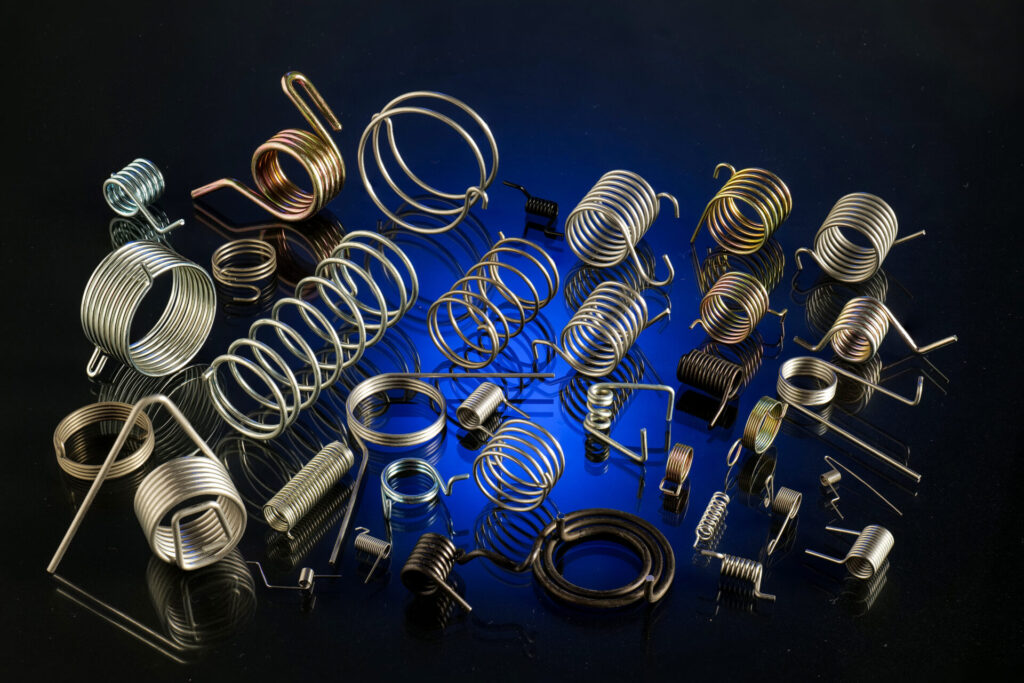
Torsion springs
Manufacturing Process of Torsion Springs:
The manufacturing process of torsion springs involves several precise steps to ensure consistent torque, durability, and reliability.
Material Selection :
- Torsion springs are typically made from high-quality materials such as music wire, stainless steel, or high-carbon steel.
- The choice of material depends on factors such as required torque, resistance to corrosion, and the application environment.
Wire Forming :
- The process begins with a coil of wire that is fed into a machine.
- The wire is then formed into a helical coil shape by a coiling machine, similar to the process used for compression springs.
Bending and Shaping :
- After coiling, the torsion spring undergoes bending and shaping to achieve the desired configuration.
- CNC (Computer Numerical Control) machines are often used for precise bending and shaping of the spring ends and legs.
End Forming :
- The ends of the torsion spring are crucial for its functionality and attachment to the application.
- Depending on the design, the ends may be formed into hooks, loops, or straight legs.
- This step ensures proper engagement and torque transfer in the application.
Heat Treatment :
- Once formed and shaped, the torsion spring undergoes heat treatment to improve its strength and flexibility.
- Heat treatment involves heating the spring to a specific temperature and then cooling it at a controlled rate.
- This process helps to set the spring’s shape, remove internal stresses, and enhance its mechanical properties.
Shot Peening(Optional):
- Shot peening can be used to improve the fatigue life and resistance to cracking of torsion springs.
- This process involves bombarding the surface of the spring with small, spherical particles to induce compressive stresses.
Surface Finishing :
- Torsion springs may undergo surface finishing processes such as coating or plating for corrosion resistance.
- This ensures longevity and reliability, especially in harsh environments.
Quality Control :
- Throughout the manufacturing process, stringent quality control measures are implemented.
- Dimensional measurements, torque testing, and fatigue testing are performed to ensure that each torsion spring meets the required specifications.
Using Torsion Springs
Door Hinges and Closures
Torsion springs are commonly used in door hinges, allowing doors to open and close smoothly.They provide the necessary torque to counteract the weight of the door and maintain its position .
Garage Doors
In garage door systems, torsion springs provide the force needed to lift and lower the door. They store energy when the door is closed and release it to lift the door when opened.
Vehicle Suspensions
Torsion bars, a type of torsion spring, are used in vehicle suspensions to provide support and control.They offer a smoother ride and help to stabilize the vehicle during cornering.
Machinery and Tools
Torsion springs are used in various machinery and tools for functions such as returning handles to their resting position.They provide precise torque and rotational force for optimal operation.
Advantages of Using Torsion Springs
Rotational Force :
Torsion springs provide reliable torque and rotational force for various applications.
Space Efficiency :
They can store significant energy in a compact space, making them ideal for applications with limited room.
Durability :
Properly manufactured torsion springs offer consistent performance and longevity, even under high loads and repeated cycles.
Customization :
Torsion springs can be designed and manufactured in various sizes and configurations to suit specific applications.
Conclusion:
Torsion springs are essential components in a wide range of mechanical systems, providing torque, rotational force, and energy storage capabilities. The manufacturing process involves precise forming, shaping, and heat treatment to ensure consistent torque and durability. Understanding the manufacturing process and the applications of torsion springs is crucial for engineers and designers to select the right components for their projects, ensuring optimal performance, efficiency, and reliability in mechanical systems.

